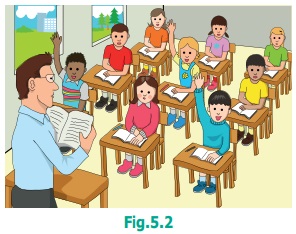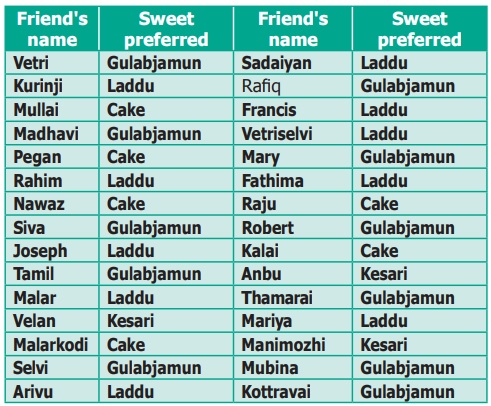Statistics | Term 1 Chapter 5 | 6th Maths - Necessity of collecting Data | 6th Maths : Term 1 Unit 5 : Statistics
Chapter: 6th Maths : Term 1 Unit 5 : Statistics
Necessity of collecting Data
Necessity
of collecting Data
Think about this situation
The Headmaster of a school (see Fig. 5.2) wanted
to open Saving Bank accounts for his students. For this, he needed data from his
students. Students did not understand the meaning of the word ‘data’. Do you know
what it means? Data means, "facts or figures from which conclusions can be
drawn". Data is collected, measured and analyzed, whereupon it can be visualized
using graphs or images. In this case, the details could consist of information like the ration
card number with address, the name of the student, Aadhaar card identity number,
date of birth, phone number for communication etc., These are preserved for drawing
inferences.


1.
Data
In our daily life, we come across many situations
where we need to collect information in the form of Facts or Numbers.
For example,
● Number of students in your class using calculators.
● Number of brothers and sisters in your family.
● Number of different types of houses in a village.
● Number of girls wearing bangles.
● Number of buses crossing a certain road junction
at a particular time.
● Number of persons in a street who watch T.V. for
more than 2 hours a day.
● Number of shops in a shopping mall selling textiles.
● Speeds of bikes, cars and other vehicles passed
along a specific highway.
Thus, the numerical
information or facts collected are known as Data.
DO YOU KNOW?
The word ‘data’ was first used in
1640’s.In 1946, the word ‘data’ also meant for “transmittable and storable computer information”. In 1954, a
termcalled‘dataprocessing’ was introduced. The plural form of ‘datum’ is ‘data’.
It also means “given” or “to give” in Latin.
2.
Collection of data
Santhi collected the following information about
her friend's preference of sweets which is as shown below.
Table: 5.1

This way of collecting the data helps Santhi to
decide, what sweets to get for her birthday and how much for each.
Activity
Collect the data of the birth months
of your classmates.
Try these
● Tabulate different kinds of crops
cultivated by the farmers in a village
● List out different kinds of plants/
trees in your school campus
3.
Types of Data
On the basis of collection, data are of two types.
They are primary data and secondary data.
Primary data
Primary data means the raw data (not tailored data)
which has just been collected from the original source and has not gone any kind
of statistical treatment like sorting and tabulation.
Examples
* List of absentees
in the class.
* A survey on writing
habits of students conducted by a pen manufacturing company.
* The types of leaves collected by students for
studying nature.
Activity
Collect data on the level of literacy
of people in your street.
Secondary Data
Secondary data consists of second hand information
which has already been collected. It could have been collected by someone other
than the user, for some other purpose.
Examples
* The Headmaster collects
the students’ absentee list from school office.
* Cricket scores gathered
from a website.
* Data from Television
and Newspapers.
* List of contact numbers from telephone directory.
Primary data is collected in person
and so more reliable than Secondary data.
Related Topics